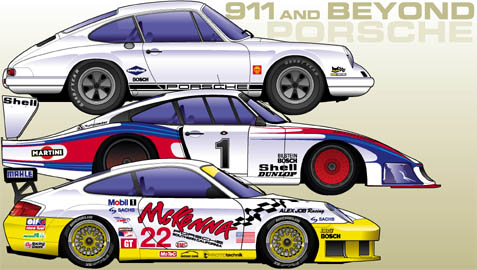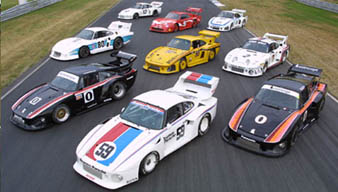From Speedvision...A Porsche Heritage Story about a Singer creation
 |
||
| An Awful Fast Pig
Racing the 911 and 935 By Bob Akin |
||
| You can’t make a racehorse out of a pig—but you can make
an awful fast pig!
The nimble Porsche 911 that debuted in the1960s was hardly a pig. In fact, the S version was one of the best performance packages available at the time. But, from the race car designer’s point of view, some things were in the wrong place—mainly the engine, which hung out behind the rear wheels, and the fuel tank in front that changed the weight distribution as it emptied. Renewed interest in racing production-based cars in the 1970s caused some great minds on both sides of the Atlantic to begin looking at the 911 as a point of departure for ever more complex and competitive race cars. Progressing rapidly through early 911-based racers, technical development, led by Porsche, finally arrived at a blindingly fast, outrageously complex, all-conquering contraption—the 935. The rules, of course, were the big problem. Production-based cars raced in IMSA, SCCA Trans-Am or European Group 5 needed to conform in some remote way the car from which they traced their origin, and there were some inviolate conditions—the size or location of the windows—front, rear and sides—and the size of the door openings, could not be altered. The type and general location of the engine and gearbox was retained and there was a minimum weight of 2050 lbs. Other than that, it was pretty much open season. Porsche delivered a number of single and, later, twin-turbo 935s, fully sorted and race ready. It was not unusual to see a sparkling new 935, still with Lufthansa shipping stickers, having just arrived at Daytona, going out and qualifying on the front row for the 24-hour race, after which the proper sponsor decals were applied. A new Porsche race car always arrived with a little dust from the test track, where it had been sorted before shipment. Porsche became known as the home of the "off the shelf race car." By early 1980, Porsche had stopped producing customer 935s and handed development to several independent race shops in Germany, Reinhold Joest and the Kremer brothers. Kremer Racing’s creative reading of the rules yielded a controversial yet technically legal modification wherein a near horizontal rear window was placed over the original sloping rear window of the 911. The result was much cleaner air delivered to the rear wing without altering the "size or location" of the original 911’s rear window, which still lived under the new structure. Flipping the gearbox upside down allowed the car to be lowered without excessive axle angle until the rear tires came very close to the bottom edge of the rear quarter window. The result, known as the Kremer 935 K-3, was an instant success and every 935 team ordered one, or sought to convert their existing cars to K-3 specs. The K-3 still used a 911 chassis/tub, although, in 1978, Porsche had created an outrageous, tube-framed streamliner nicknamed Moby Dick that had posted the fastest speed down the Mulsanne straight at Le Mans that year: 227.5 mph! By 1981, Joest had acquired the plans for the Moby Dick car and produced several replicas. Kremer offered an aluminum tube-framed K-4 and American IMSA competitors including Andial, J.L.P. and my own Atlanta-based team began building several successful (and some not so successful) 935 variants. Yet the days of the 935 were numbered. IMSA boss John Bishop was sick of watching Porsches win all his races (the saying was, "Having a Porsche didn’t guarantee you were going to win, but not having one guaranteed you were going to lose!"). Bishop promulgated the GTP regulations as a way of breaking Porsche’s grip on the Camel GT Series and, in 1981, Brian Redman’s heroic effort in a Lola T-600 GTP, running the entire season with a cracked windshield because there were no spares, won the IMSA championship. The 935s came back to win in subsequent years and were a force to reckon with until the Porsche 962s GTPs arrived in 1984. Porsche offered 962s to their established racing customers and in short order John Bishop’s nightmare returned: Porsches won everything. A few 935s continued to compete successfully, mainly in the long races, but the GTP cars ,with their awesome cornering and braking, were clearly the class of the field. Everything was in the right place—engine and fuel tank in the center, real race car suspension, ground effects and a slippery shape. It took direct intervention on the part of the Jaguar, Nissan and Toyota factories to finally end the 962 domination. In my opinion, they also killed the IMSA GTP series in the process with their ultra-complicated "laboratory curiosities." The Porsche 935 may not have been a thoroughbred and the 911 was hardly a pig, but the journey between the two yielded some remarkable race cars and a string of victories seldom if ever equaled. Along the way the 935s carried many of us safe and fast for thousands of miles and for this, above all, I am grateful. I will remain a 935 fan forever. |
Pressed
into service
as a production-based race car (TOP), the 911 concept was expanded into the radical "Moby Dick" 935 (MIDDLE) decades—and is still winning races today as the 911 GT3 RS (BOTTOM). (Illustration by Paul Laguette.) Porsche Heritage stories |
|

Taking advantage of a loophole in the rules, the 935s took Porsche domination of the GT category to new heights in the late ’70s. |
||
Porsche Motorsport 2000 Home